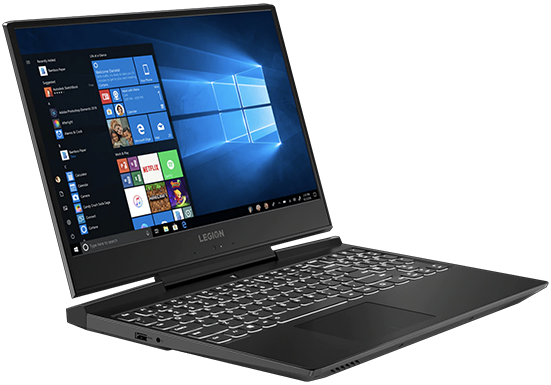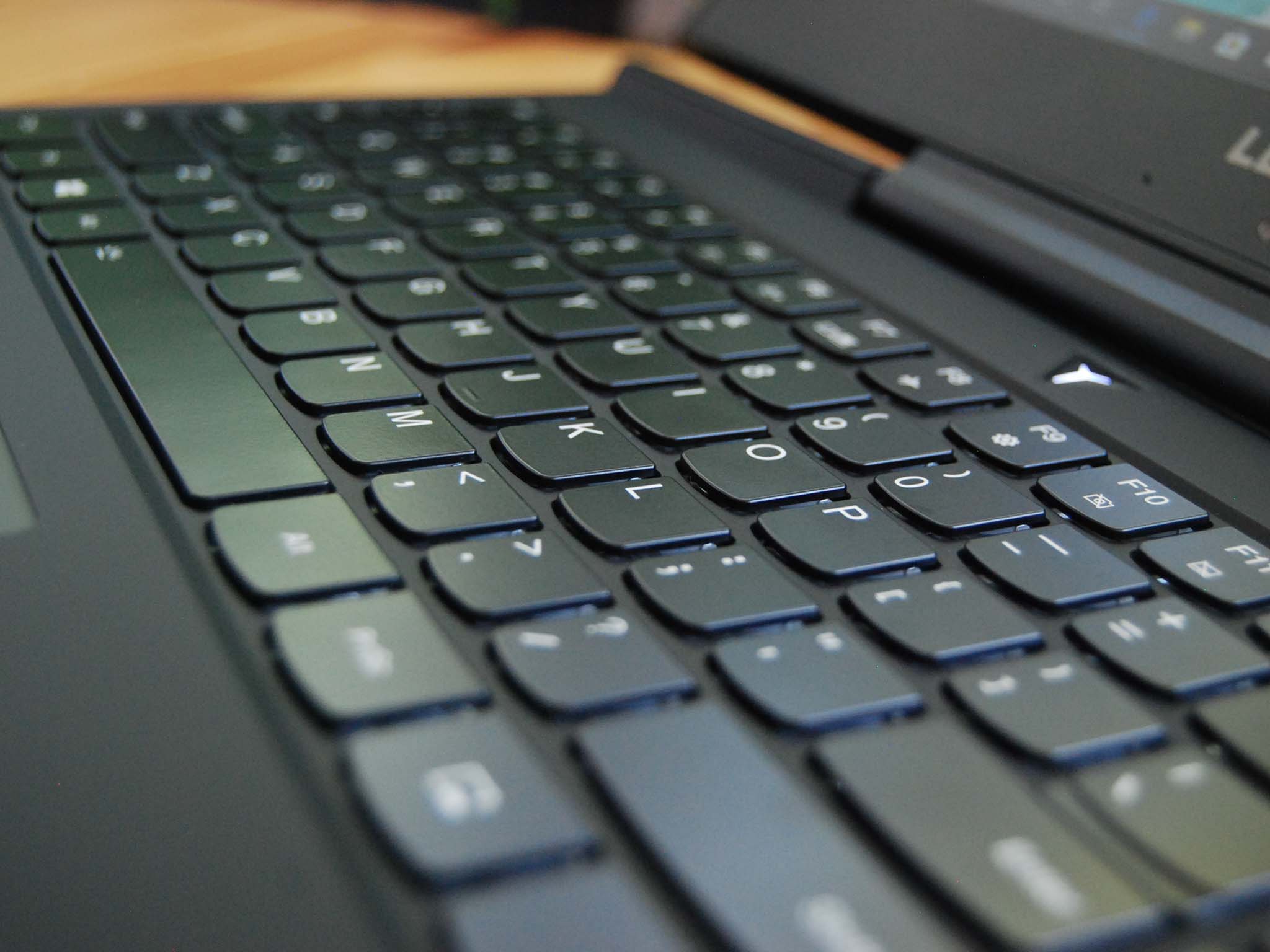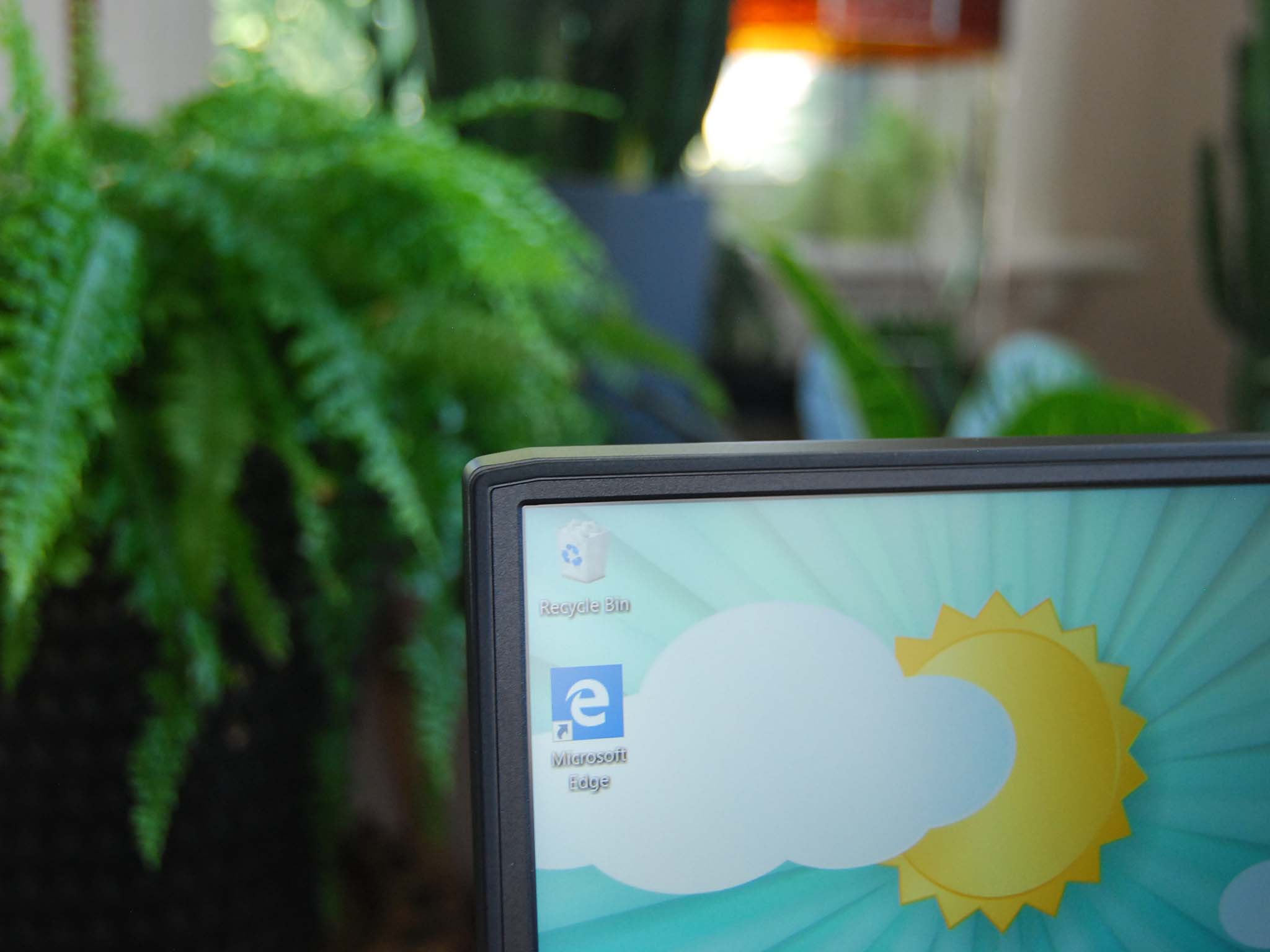
Lenovo's Legion Y545 is an interesting addition to its 500-series lineup of gaming laptops. It's built with the same single-hinge chassis that we saw used for the budget Legion Y7000, but it's outfitted with performance hardware that you'll also find in the Legion Y540 that's built with the updated chassis we also saw in the impressive Legion 700-series lineup. It's a bit confusing, especially when you see how close pricing is between the Y540 and Y545, but the latter laptop we have here for review is ultimately a bit cheaper when you don't factor in Lenovo's frequent sales and instant savings offers. I used the Legion Y545 for about a week to see whether or not it's worth your hard-earned dough.

From $900Bottom line: The Legion Y545 is an interesting alternative to the Y540, coming at you with a bulkier design and slightly cheaper price. It does suffer from some thermal issues, but for the most part, it's going to deliver excellent performance.
Pros
- Excellent keyboard
- Plenty of configuration options available
- 60Hz or 144Hz FHD display options
- Rear port orientation for easy cable management
- RAM, SSD, and HDD can be upgraded
Cons
- Webcam under display
- Some thermal throttling under heavy load
- Slow M.2 SSD
- Speakers are average
Lenovo Legion Y545 at a glance

Lenovo supplied Windows Central with a review unit of the Legion Y545, with 9th Gen Intel Core i7-9750H processor (CPU), 16GB of DDR4-2666MHz RAM, NVIDIA GTX 1660 Ti graphics card (GPU) with 4GB of VRAM, and a 128GB PCIe solid-state drive (SSD) coupled with a 1TB SATA hard-disk drive (HDD) for mass storage. It's also equipped with an FHD non-touch display with a 60Hz refresh rate; for those who want a smoother picture, there's likewise a 144Hz option available for a bit more money.
This exact configuration costs about $1,210 at Lenovo, though baseline models with 9th Gen Intel Core i5-9300H CPU, 8GB of RAM, a 1TB HDD, and NVIDIA GTX 1650 GPU start at about $900.
For a fully specced model, including Core i7 CPU, 32GB of RAM, NVIDIA RTX 2060 GPU, 2TB HDD with 1TB SSD, and 144Hz FHD display, you're looking at about $1,915.
| Category | Spec |
|---|---|
| Display | 15.6 inches 1920 x 1080 (FHD) IPS, non-touch 60Hz refresh rate |
| Processor | 9th Gen Intel Core i7-9750H Up to 4.50GHz Six cores |
| RAM | 16GB (dual 8GB) DDR4-2666MHz |
| Storage | 128GB M.2 PCIe NVMe SSD 1TB SATA HDD |
| Graphics | NVIDIA GTX 1660 Ti (4GB) |
| Ports | USB-C 3.1 (Gen 1) three USB-A 3.1 (Gen 1) HDMI 2.0 RJ45 Ethernet Mini DisplayPort 1.4 3.5mm audio |
| Audio | Dual 2W speakers Dolby Atmos |
| Camera | Front-facing 720p |
| Wireless | Intel Wireless-AC 9560 802.11ac (2 x 2) Bluetooth 4.2 |
| Battery | 52.5Wh (NVIDIA GTX 1650) 57Wh (NVIDIA GTX 1660 Ti, RTX 2060) |
| Dimensions | 14.22 x 10.5 x 0.97 - 1.05 inches (361.1mm x 266.7mm x 24.7 - 26.6mm) |
| Weight | From 5.1 pounds (2.3kg) |
What you'll love about the Legion Y545

The Legion Y545's chassis has a soft-touch finish for the black interior, and while it does pick up some smudges like a ThinkPad, it feels rather luxurious to hold. The aluminum lid has a sizeable Legion logo that lights up when the laptop is in action, and it has some slight tapering along the edges for an aggressive look. This design is heightened by the relatively thick rear end, complete with dual exhaust vents and a generous collection of ports that makes cable management easy if you're primarily operating at a desk. The laptop weighs about the same as most of Lenovo's 15-inch options at around five pounds; it's not the most portable device, but it's not going to drag you down like the 17-inch Legion Y740.
Along the back are Lenovo's proprietary charging port for the beefy 230W adapter, USB-A 3.1, a single USB-A 3.1, HDMI 2.0, RJ45 Ethernet, and Mini DisplayPort 1.4, while the sides of the laptop each have another USB-A 3.1 port that's handy for an external gaming mouse. The left side also has a 3.5mm audio jack for your gaming headset. This should be enough ports for most gaming accessories, and if you have VR ambitions, you shouldn't have any issues connecting, say, and Oculus Rift S, which you can actually find bundled with some Y545 models.

The review model has a 15.6-inch display with 60Hz refresh rate — you can opt for a 144Hz option, which makes the most sense if you also go with the powerful RTX 2060 GPU — complete with a thin bezel around the top and sides. It promotes a modern look, though the single hinge in the middle of the lid does make it ultimately feel a bit flimsy, especially when compared to the dual-hinge setup used in the Y540.
All the latest news, reviews, and guides for Windows and Xbox diehards.
The display only gets up to about 300 nits brightness, but the matte finish helps deal with glare in well-lit rooms. I didn't have much trouble gaming indoors, though if you like to enjoy the sun while having some fun, you'll probably find yourself squinting at the screen. Color reproduction hits 96% sRGB and 73% AdobeRGB, both respectable results that are evident as soon as you open the lid. Games look great on this display, and the FHD resolution is well-suited to the size.

Like the Legion Y7000, the keyboard stretches from edge to edge, leaving enough space for sizeable keys and a number pad. There's plenty of travel and spacing is comfortable when using the WASD keys and their surrounding counterparts, and the spacebar is balanced to prevent misclicks while gaming. If you want your laptop to have customizable RGB lighting behind the keyboard, you'll have to move to Lenovo's 700-series, because the Y545 uses a three-stage white backlight with no customization options.
The Precision touchpad is relatively large, and the mylar surface makes for smooth pointing, though it's safe to assume most gamers are going to promptly plug in a mouse for far better control. My main grievance with the touchpad is its off-center placement, which puts it under your left palm while using the WASD keys. There's a Fn key shortcut along the top of the keyboard to turn off the touchpad completely, and the break in the chassis for the touchpad is minimal enough that you probably won't notice your hand rubbing along it. Still, it's something to note.

There are quite a few configuration options for the Legion Y545 once you get past the 9th Gen Intel Core i5 or Core i7 CPU, including up to 32GB of DDR4-2666MHz RAM, 2TB HDD and 1TB SSD, and NVIDIA GTX 1650, GTX 1660 Ti, or RTX 2060 GPU. If you need to save some money now, you can always opt for lesser storage and RAM and upgrade at a later date thanks to easy internal access.
The Legion Y545, especially with maxed-out specs, delivers a ton of gaming power.
The review unit is equipped with mid-range hardware and the $1,210 price reflects that, but it still delivers a satisfying gaming experience. Along with the synthetic benchmarks below, I played some Tom Clancy's The Division 2 and Apex Legends to get an idea for average framerates you can expect.
In The Division 2, with High graphics preset, the Y545 averaged 73.4 FPS, while a round of Apex Legends averaged 79.5 FPS with graphics maxed out. Unless you've opted for the 144Hz display, these numbers should satisfy. You will hear the fans kick on when under load, but volume isn't egregious and should be drowned out by the loud (but hollow) speakers. I also ran some stress tests, and unfortunately, there was some thermal throttling in the 5% to 15% range when under full load. That's not something we saw in the pricier 700-series laptops.
3DMark
Time Spy (Higher is better)
| Laptop | GPU | Score |
|---|---|---|
| Lenovo Legion Y545 | GTX 1660 Ti | 5,482 |
| Lenovo Legion Y7000 | GTX 1060 | 3,975 |
| Lenovo Legion Y740 15 | RTX 2070 Max-Q | 6,406 |
| Lenovo Legion Y740 17 | RTX 2080 Max-Q | 7,128 |
| Dell G7 15 7588 | GTX 1060 | 3,792 |
| Lenovo Legion Y720 | GTX 1060 | 3,469 |
The NVIDIA GTX 1660 Ti holds its own against the RTX options in the 700-series Legion laptops. You're not going to get the same performance or perks (like ray tracing), but you will save quite a bit of money.
3DMark
Fire Strike (Higher is better)
| Laptop | GPU | Score |
|---|---|---|
| Lenovo Legion Y545 | GTX 1660 Ti | 12,598 |
| Lenovo Legion Y7000 | GTX 1060 | 10,137 |
| Lenovo Legion Y740 15 | RTX 2070 Max-Q | 14.669 |
| Lenovo Legion Y740 17 | RTX 2080 Max-Q | 16,303 |
| Dell G7 15 7588 | GTX 1060 | 10,029 |
| Razer Blade 15 | GTX 1070 | 13,560 |
VRMark
Orange Room (Higher is better)
| PC | GPU | Score |
|---|---|---|
| Lenovo Legion Y545 | GTX 1660 Ti | 7,792 |
| Lenovo Legion Y740 15 | RTX 2070 Max-Q | 8,537 |
| Lenovo Legion Y740 17 | RTX 2080 Max-Q | 8,885 |
| Lenovo Legion Y730 | GTX 1050 Ti | 3,742 |
| Acer Predator Triton 700 | GTX 1080 | 8,592 |
The GTX 1660 Ti GPU will easily handle most VR games, including Beat Saber which I played with Oculus Rift S. If you're looking to get into serious VR, though, with mods and all effects, you will want something with more power and might even want to consider a full desktop.
CPU
Geekbench 4.0 Benchmarks (Higher is better)
| Device | CPU | Single core | Multi core |
|---|---|---|---|
| Lenovo Legion Y545 | i7-9750H | 5,530 | 23,550 |
| MSI PS63 Modern | i7-8565U | 4,909 | 14,466 |
| Razer Blade Stealth | i7-8565U | 5,139 | 16,339 |
| Lenovo Legion Y7000 | i7-8750H | 5,134 | 22,540 |
| Lenovo Legion Y40 15 | i7-8750H | 4,975 | 22,294 |
| Lenovo Legion Y740 17 | i7-8750H | 5,067 | 22,578 |
| Dell G7 15 7588 | i7-8750H | 4,897 | 21,245 |
| Razer Blade 15 | i7-8750H | 4,872 | 17,910 |
The 9th Gen Intel Core i7-9750H brings awesome power, beating out the 8th Gen options in the 700-series Legion laptops. The issues here is that the cooling system doesn't seem to be able to keep the CPU cool under heavy load.
PCMark
PCMark Home Conventional 3.0
| Device | Score |
|---|---|
| Lenovo Legion Y545 | 4,943 |
| Lenovo Legion Y7000 | 4,097 |
| Lenovo Legion Y740 15 | 4,789 |
| Lenovo Legion Y740 17 | 5,102 |
| Dell G7 15 7588 | 3,853 |
| Acer Predator Triton 700 | 4,205 |
| Lenovo Legion Y720 | 3,599 |
SSD
CrystalDiskMark (Higher is better)
| Device | Read | Write |
|---|---|---|
| Lenovo Legion Y545 | 1,585.1 MB/s | 321.1 MB/s |
| Razer Blade Stealth | 2,850 MB/s | 1,087 MB/s |
| MSI PS63 Modern | 3,300 MB/s | 1,875 MB/s |
| Lenovo Legion Y7000 | 3,493.5 MB/s | 1,653.8 MB/s |
| Lenovo Legion Y740 15 | 3,395.1 MB/s | 1,549.7 MB/s |
| Lenovo Legion Y740 17 | 3,356.6 MB/s | 1,388.1 MB/s |
| Dell G7 15 7588 | 521.5 MB/s | 303.4 MB/s |
| Razer Blade 15 | 2,722 MB/s | 1,217 MB/s |
| Acer Predator Triton 700 | 3,353.5 MB/s | 1,859.3 MB/s |
The M.2 PCIe SSD is rather disappointing, but at least it can be upgraded after purchase. The SATA HDD, as expected, was even slower, hitting 178.4 MB/s read and 171.0 MB/s write speeds.
What you'll dislike about the Legion Y545

Other than the off-center touchpad, thermal throttling under heavy load, slow SSD, and lack of RGB keyboard lighting, I have to ding the webcam placement. It's centered below the display for a bad angle, but if you're serious about streaming, you're no doubt going to invest in a quality external option with a much better picture.
Battery life is about what's expected of a standard gaming laptop, averaging somewhere between one and two hours when playing intensive games. You'll get an extra couple of hours if you're using the laptop for general tasks, or if you're playing low-impact games. I ran some Spelunky for just over an hour and still had about 75% charge. The 230W AC adapter is an absolute beast, so if you plan on often carrying this laptop with you, be sure you make accommodations in your laptop bag.
Should you buy the Lenovo Legion Y545?

The Legion Y545, with bulkier chassis and (in my mind) inferior single hinge system, seems like it should be a budget alternative to the Y540, but Lenovo's pricing, with frequent coupons and instant savings, often muddles the lines. With both laptops, you're getting awesome performance for the price, but it's unclear whether the Y540 sees the same thermal issues (we weren't able to test it out).
The Y545 is ultimately positioned as a Y540 alternative, but if you have a bit more room in your budget, there's also the Legion Y740 15 to seriously consider. It's one of the best gaming laptops we tested all year, bringing quiet but optimal thermal control, superb performance, and the modern, sleek design you'll also find in the Y540.

Cale Hunt brings to Windows Central more than nine years of experience writing about laptops, PCs, accessories, games, and beyond. If it runs Windows or in some way complements the hardware, there’s a good chance he knows about it, has written about it, or is already busy testing it.
